Hayden on bush foods
The material below comprises summarised versions of some of the plant descriptions from the erstwhile Melbourne Bushfood website. Melbourne Bushfood, of which Hayden Marks was the founder, used to sell a wide range of bush foods (both the foods themselves and the plants).
Brush cherry (Syzygium australe)
 The brush cherry is one of the best native fruits. It’s crisp, apple-textured fruit is slightly acidic but sweet when ripe. You can eat them raw or as an ingredient in jams, juices, tarts, cakes or sorbet.
The brush cherry is one of the best native fruits. It’s crisp, apple-textured fruit is slightly acidic but sweet when ripe. You can eat them raw or as an ingredient in jams, juices, tarts, cakes or sorbet.
In cultivation, the brush cherry is typically a small tree, reaching 2-4 metres (it can grow much taller in the wild). It can produce copious amounts of fruit even in small containers. It can be hedged, making it an ideal suburban garden plant or privacy screen. It grows best in full sun but can also have reasonable results in part shade.
Being a rainforest species, drying out is a common cause of death, especially for younger plants. When dry, it will wilt, which is a good indication of when to water.
To ensure continued fruiting, it’s important that you feed regularly with a native plant food.
Harvest the fruit when they have turned a bright red/pink colour or are falling from the tree.
Finger lime (Citrus australasica)
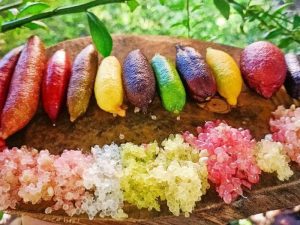 The innards of the finger-shaped finger lime fruit physically resemble caviar and taste not dissimilar to grapefruit or lime (i.e. sour citrus). You can use in sorbets, desserts or any other dish were citrus is needed. The fruit can also be either frozen or dehydrated.
The innards of the finger-shaped finger lime fruit physically resemble caviar and taste not dissimilar to grapefruit or lime (i.e. sour citrus). You can use in sorbets, desserts or any other dish were citrus is needed. The fruit can also be either frozen or dehydrated.
There are lots of varieties, each with a different taste. The green varieties are more acidic and eucalypty, similar to limes, the red varieties are typically lighter in flavour with hints of grapefruit, and the yellow ones are more lemony.
The plant is a small tree growing up to 3 metres tall. Plant in full sun and use citrus fertiliser (rather than native fertiliser). You can also grow it in pots.
Harvest the fruit when mature. Mature finger limes are typically about 5-7cms long and 2cms in diameter. They should be plump, rounded and slightly soft.
 Geraldton wax (Chamelaucium uncinatum)
Geraldton wax (Chamelaucium uncinatum)
This herb has zesty and uplifting leaves that are used as a garnish to bring a lemony flavour to your dish. Alternatively, blend the leaves with some oil and a pinch of salt to create a green salsa-verde paste. The flowers, whilst not super palatable, are edible in small quantities and can be used to decorate desserts and dishes.
The plant typically grows to around 1 metre high and requires full sun to part shade. It can be grown in the ground or in pots. It is relatively hardly and fairly easy to grow in the Melbourne climate. Endemic to Western Australia, it is adapted to dry lands, so water sparingly and ensure the soil at the base is dry before giving it another drink. The colourful flowers are great for attracting bees to the garden.
Different varieties of Geraldton wax taste different so, before you buy a seedling to plant in your garden, eat one of the leaves to make sure that you like the taste of that particular plant.
Kurrajong or Illawarra flame tree (Brachychiton acerifolius)
 The seeds, after roasting with spices, are a tasty, protein-rich snack. Spread the seeds on a baking tray and place them in the oven at 180degC for 20-30 minutes. Once roasted, the seeds can be used in a variety of dishes, such as soups, stews and curries. They can also be ground into a flour and used as a gluten-free substitute in baking.
The seeds, after roasting with spices, are a tasty, protein-rich snack. Spread the seeds on a baking tray and place them in the oven at 180degC for 20-30 minutes. Once roasted, the seeds can be used in a variety of dishes, such as soups, stews and curries. They can also be ground into a flour and used as a gluten-free substitute in baking.
As young plants, kurrajongs were traditionally eaten as a vegetable similar to a carrot, and the adult plants’ roots were used as a source of water during dry times.
The seeds are contained in large seed pods, which develop only on mature trees. Wait until the pods have dried out and turned brown before harvesting them. To harvest, trim the seed pods from the tree and, before removing the seeds, ensure that you are wearing gloves. The seeds are coated with fine fibres, which are very irritable. Either leave the seeds in a bag for a long period until the fibres fall naturally from the seed, or scorch the seeds with a hot flame for a short period of time.
The plant is a large, deciduous tree growing up to 30 metres. It has bright red flowers in late summer, which coat the tree giving the impression that the plant is covered by a red flame. Unlike most plants, it does not flower each year.
Plant in either full sun or part shade. It grows well in any type of soil and is drought-tolerant. It will benefit from the annual application of a native fertiliser.
If regularly pruned, it can be grown in a pot, either indoors or outdoors, as it doesn’t die from root-bounding, but make sure that the pot is well draining as over-watering or sitting-in-water can cause damage to the plants roots.
Lemon or lemon-scented myrtle (Backhousia citriodora)
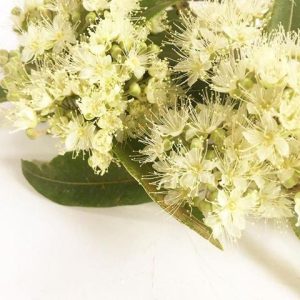 The leaves have a lemony flavour and can be eaten either dry or fresh, with either the whole leaf being used or milled finely in a powder. They are a fragrant and versatile flavouring which can be used in a wide variety of both sweet and savolury dishes, including ice cream, desserts, cocktails, poured into baked goods, sprinkle over fish and with white meat. The lack of acidity means that it doesn’t curdle dairy-based desserts. Avoid using with foods that require long cooking times (such as roast dinners). The leaves are also commonly used in teas and therapeutic products. They can also be distilled to give the essential oil citral.
The leaves have a lemony flavour and can be eaten either dry or fresh, with either the whole leaf being used or milled finely in a powder. They are a fragrant and versatile flavouring which can be used in a wide variety of both sweet and savolury dishes, including ice cream, desserts, cocktails, poured into baked goods, sprinkle over fish and with white meat. The lack of acidity means that it doesn’t curdle dairy-based desserts. Avoid using with foods that require long cooking times (such as roast dinners). The leaves are also commonly used in teas and therapeutic products. They can also be distilled to give the essential oil citral.
The leaves are considered to have both anti-bacterial and anti-fungal properties.
The plant is a shrub which, in cultivation, typically grows to around 2 metres (it can be much taller in the wild). It has dense, green, aromatic foliage, with the leaves having a strong citrus fragrance when crushed. Ideally, plant in full sun or, failing that, in part shade. The plant is both drought tolerant and frost tolerant when mature, but somewhat tender when young.
To harvest, simply pluck the leaves off when required.
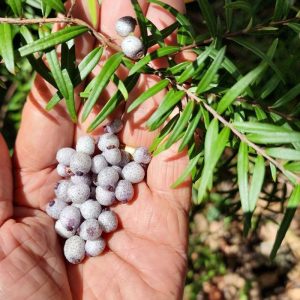 Midyim berry (Austromyrtus dulcis)
Midyim berry (Austromyrtus dulcis)
The midyim berry has numerous, small, sweet berries which are best eat raw. They are one of the tastiest native fruits, with a touch of eucalypt and spice. The berries appear in late autumn.
The plant grows to around 50cm in both height and width. Grow in full sun (or part-shade with less fruiting). Suitable for growing in pots.
One plant can yield over 1kg of berries with correct care, with correct watering, fertilising and pruning key to a large bounty. They are generally drought tolerant but can experience problems with overwatering so water only when the soil becomes dry, and make sure the soil is well-draining. Fertilise with a native fertiliser immediately after harvesting and regularly spray with a seaweed solution. Trim lightly after harvesting to keep the plant bushy and well maintained.
Muntries (Kunzea pomifera)
 The small, blueberry-size fruit taste like a granny smith apple but with a little bit of eucalyptus. As well as being eaten fresh, they can be used in chutneys, preserves, syrups, juices, beverages, sauces, muffins, fruit leathers, jellies, specialty breads or fresh salads.
The small, blueberry-size fruit taste like a granny smith apple but with a little bit of eucalyptus. As well as being eaten fresh, they can be used in chutneys, preserves, syrups, juices, beverages, sauces, muffins, fruit leathers, jellies, specialty breads or fresh salads.
The plant is a slow-growing, low-growing (up to 30cm tall), spreading (up to 2 metres wide) shrub. Plant in either full sun or part-shade. It can also be grown in either pots on hanging baskets.
Muntries’ woody branches and tough leaves make it very drought and pest tolerant. After the fruiting season, give it a high quality native fertiliser boost.
The berries are ripe when they have turned from green to purplish/red and have become fragrant. In some varieties, the berries remain green even when ripe.
Murnong or yam daisy (Microseris scapigera)
 Murnong is a tuberous native yam that has a distinct nutty taste when roasted. They can also be eaten raw or baked, mixed with other vegetables or turned into a paste for desserts.
Murnong is a tuberous native yam that has a distinct nutty taste when roasted. They can also be eaten raw or baked, mixed with other vegetables or turned into a paste for desserts.
There are three species of murnong: Microseris lanceolata has a single fleshy root; Microseris scapigera has several cylindrical or long-tapered roots; and Microseris walteri has a single long, tapered root. Melbourne bushfood sell Microseris scapigera.
The plant is perennial and typically grows to around 30cm tall and wide. It can be grown in most types of soil, although best in loam. It needs regular watering in summer. Unlike most natives, using a fertiliser that contains phosphorus yields larger tubers. It also benefits from regular (e.g. monthly) applications of a seaweed solution.
The plant can be propagated by uprooting the tubers, separating them and re-planting. Seed sowing is also possible.
The tuber roots are ready for harvesting when the flowers blossom in Autumn. Simply dig them up or gently wiggle the leaves and uproot the tuber. It is best not to harvest your murnong for the first two years as the tubers will only be small.
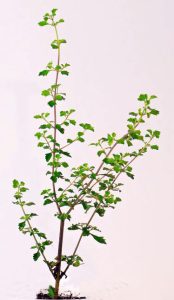 Native thyme (Prostanthera incisa)
Native thyme (Prostanthera incisa)
A part of the mint family, native thyme holds a deeper flavour than found in other mints, with earthy notes and a slight pepperiness.
To harvest, just pluck fresh leaves off the growing plant or cut off whole stalks. Both leaf and stem may be used – fresh, or chopped and dried for later use. Just remember that the flavour will fade over time after harvesting.
The plant is an evergreen shrub which grows to around 2 metres tall and wide. Alternatively known as cut-leaf mint-bush, it flowers in early spring, with small, bright pink/purple flowers, similar to other mint-bushes. It is fast growing, with annual pruning encouraging new growth. It also grows well in pots, playing a similar role to a rosemary shrub.
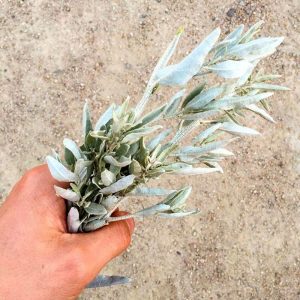 Old man’s saltbush (Atriplex nummularia)
Old man’s saltbush (Atriplex nummularia)
The leaves have a rich salty flavour but with low bitterness. Fresh, they can be mixed into a salad or stir fry. Dried, they are an earthy substitute to regular salt and can be used as a seasoning on slow cooked meats, stews, curries and soups or added on to roasted vegetables to give a herby flavour. Traditionally, the dried leaves have been used as a flavouring in bread and sourdough.
Simply pluck off leaves as needed. Make sure to wash before using.
The plant is a hardy shrub with pale-green leaves that can grow to around 2 metres tall and wide. It has a tendency to shoot straight up (like bamboo) and thus benefits from regular pruning. It can be grown in any type of soil and is drought tolerant. It is suitable for growing in pots.
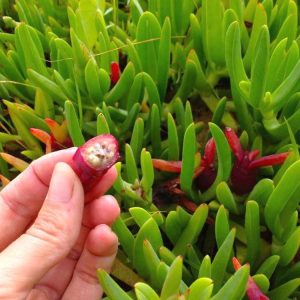 Pigface (Carpobrotus)
Pigface (Carpobrotus)
The leaves can be pickled into a preserve. The fruit is tasty, sweet, and tastes like a salty kiwi with touches of melon.
The plant is a groundcover, spreading to around 2 metres. Bright pink daisy flowers cover the bush throughout much of the year. It can tolerate a range of soil conditions (clay soils) and is drought tolerant. Plant in either full sun or part shade.
The plant can easily be propagated by layering (rooting horizontal stem cuttings).
The fruit is ripe when it becomes soft and a deep red colour.
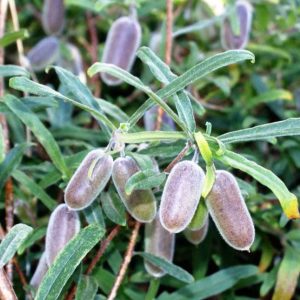 Sweet appleberry (Billardiera cymosa)
Sweet appleberry (Billardiera cymosa)
The berries are textured like apples when unripe but go soft when ready to eat. They have an interesting mixed flavour reminiscent of stewed apples and kiwifruit. They can be used in jams, tarts, cakes or preserving.
The plant is a climber growing to up to 2 metres. In Spring, it produces clusters of bright, bell-shaped, pink flowers.
Plant in either full sun or shade, near a structure that it can grow up. Alternatively, grow in either a pot or a hanging basket. It is both hardy and drought tolerant. It can also tolerate poor soils.
The berries are ripe when they turn from green to yellow and start to soften. Gently pluck the berries off the branches, making sure not to damage the plant.
A related plant, with similarly edible fruit and climbing disposition, is Billardiera scandens, commonly known as simply appleberry or apple dumpling.
Tasmanian pepperberry or mountain pepper (Tasmannia lanceolata)
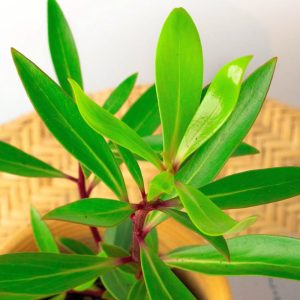 Both the leaves and the berries have a strong peppery taste and can be used as a replacement for regular black pepper. As such, when dried they are used as a spice and pair well with curries, cheese, salad dressings and sauces, giving them a spicy flavour. The berries were also used traditionally as medicine to cure skin diseases.
Both the leaves and the berries have a strong peppery taste and can be used as a replacement for regular black pepper. As such, when dried they are used as a spice and pair well with curries, cheese, salad dressings and sauces, giving them a spicy flavour. The berries were also used traditionally as medicine to cure skin diseases.
The plant is dioecious (separate male and female plants) so you will need both male and female plants to obtain harvest berries.
The plant is an evergreen shrub which grows up to 3 metres tall. It has yellow/creamy white flowers that turn into red berries that then darken as they ripen. It grows best in part shade and is also suitable for growing in pots.
Warrigal greens (Tetragonia tetragonioides)
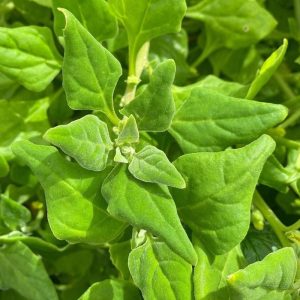 As suggested by its alternative common name of New Zealand spinach, the leaves of warrigal greens taste a bit like English spinach but with a crunchier texture (so it’s less like eating a leaf). Because of their high level of oxalates, the leaves need to be blanched before eating. You can then cook and use the leaves as you would spinach, including sautéing, stir-frying or cooked in a quiche or pie.
As suggested by its alternative common name of New Zealand spinach, the leaves of warrigal greens taste a bit like English spinach but with a crunchier texture (so it’s less like eating a leaf). Because of their high level of oxalates, the leaves need to be blanched before eating. You can then cook and use the leaves as you would spinach, including sautéing, stir-frying or cooked in a quiche or pie.
The plant is a groundcover, spreading to around 2 metres. Plant in full sun or part shade. As it’s only able to handle light frosts, you will want to keep your plant sheltered. It is suitable for growing in pots. It is reasonably drought tolerant but will still need watering in summer.
Harvest individual leaves when they reach roughly the size of your hand. Avoid the woody stems as they can be tough and difficult to eat.
